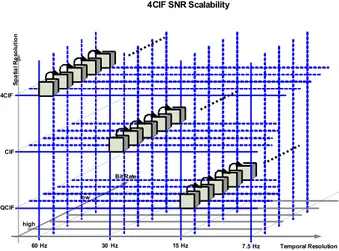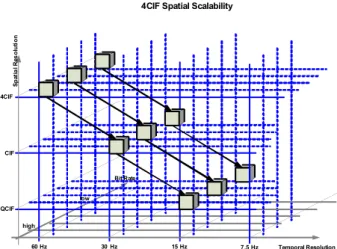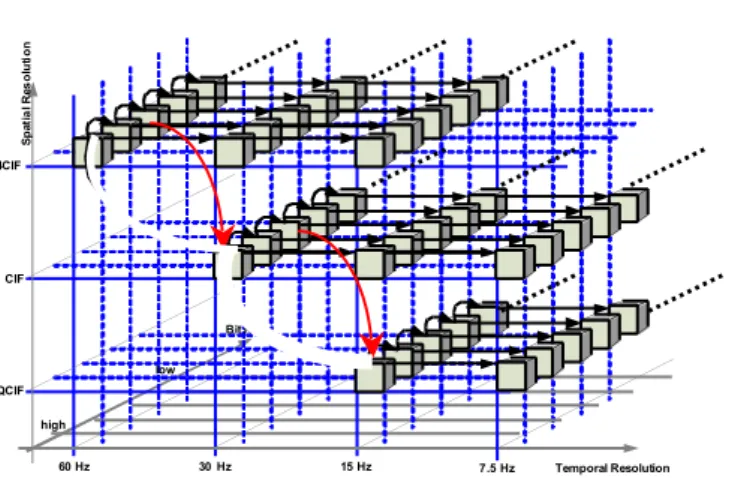INTERNATIONAL ORGANISATION FOR STANDARDISATION
ORGANISATION INTERNATIONALE DE NORMALISATION
ISO/IEC JTC1/SC29/WG11
CODING OF MOVING PICTURES AND AUDIO
ISO/IEC JTC1/SC29/WG11
MPEG2006/
N7823
January 2006, Bangkok, Thailand
Source Video
Title Description of Testing in Wavelet Video Coding Status Approved
Authors Riccardo Leonardi, Sébastien Brangoulo, Marta Mrak, Mathias Wien, Ji-zheng Xu
Contacts: [email protected], [email protected], [email protected], [email protected], [email protected]
The provided testing scenario is intended to be used for evaluation of the coding performance of the JSVM coding scheme provided by JVT, with respect to the Exploration Wavelet Video Coding platform. The reference conditions have been derived from the JSVM testing conditions document JVT-P205 produced at the 16th JVT meeting in Poznan. Further details on JSVM configuration can be found in such document.
The rate points to be used in all tests are derived from the combined scalability test sets. The applicable set of rate points is similar to the rate points originally applied in the Munich and Palma testing conditions. The target rates are arranged in a systematic manner.
For each spatio-temporal resolution, the rate triples from the lowest rate point to the highest rate point.
The settings are chosen such that an AVC compatible base layer can be provided for the base layer of combined and spatial scalability and for the QCIF sequences in the SNR scalability scenario.
The encoder will generate embedded bit-streams. To extract the various bit-rates, frame-rates and resolutions specified in the tables below from the embedded bit-stream, an extractor shall be used. No transcoding is allowed for performing the decoding at the various bit-rates, frame-rates and resolutions.
In the combined scalability settings, the testing addresses a broad range scalability and is motivated by the requirements of applications such as surveillance, broadcast and storage systems. This scenario is represented by the test sequences CITY, CREW, HARBOUR and SOCCER.
Visual tests shall take place for the rates shown in green in the tables below for each spatial resolution, and for the Palma test at the rate points tested at Palma. PSNR curves will have to be provided for all other rate points.
1 SNR Scalability (SNR)
For evaluation of SNR scalability functionality, no spatial scalability is included. A single spatial layer is encoded in the bit stream. For the QCIF layers, this configuration corresponds to the lowest layer of the combined scalability test.
Extraction Paths
The extraction paths for SNR scalability are straight forward. The rates for a single spatial resolution are successively extracted. The extraction paths for SNR scalability are shown in Figure 1 below. Temporal Resolution S p a tia l R e so lu ti o n Bit Rate CIF 4CIF QCIF 60 Hz 30 Hz 15 Hz 7.5 Hz high low 4CIF SNR Scalability
Figure 1: 4CIF extraction path for SNR scalability.
Rate Points
In the SNR scalability testing scenario, the extracted streams are required not to exceed the target rate points.
Sequence Format Bit rates (kbit/sec)
City QCIF 15Hz 64 80 96 120 144 168 192 CIF 30Hz 256 320 384 480 576 672 768 4CIF 60Hz 672 848 1024 1280 1536 1792 2048 Crew, Harbour, Soccer QCIF 15Hz 96 120 144 180 216 252 288 CIF 30Hz 384 480 576 720 864 1024 1152 4CIF 60Hz 1024 1280 1536 1920 2304 2688 3072
2 Spatial Scalability (SPA)
In order to generate rate/distortion plots, three separate streams are encoded including three spatial layers for the 4CIF sequences.
Extraction Paths
The extraction paths for spatial scalability are straight forward. The bit stream includes each spatial layer at a single fixed target rate. The extraction paths for spatial scalability are shown in Figure 2 below. Temporal Resolution S p at ia l R es o lu ti o n Bit Rate CIF 4CIF QCIF 60 Hz 30 Hz 15 Hz 7.5 Hz high low
4CIF Spatial Scalability
Figure 2: 4CIF extraction paths for spatial scalability.
Rate Points
In the spatial scalability testing scenario, the extracted streams are required not to exceed the target rate points by more than 2%.
Sequence Format Bit rates (kbit/sec)
City - - - - CIF 30Hz 192 384 576 4CIF 60Hz 576 1152 1728 Crew, Harbour, Soccer - - - - CIF 30Hz 384 576 768 4CIF 60Hz 1536 1728 2304
3 Combined Scalability (CMB)
The Palma test conditions and rate points are used for this test.
4 Extended Scalability Performance (EXT)
This will not be necessary part of any visual performance evaluation at the Montreux meeting, but can be a basis for further study.
In this combined extended scalability scenario, extraction from an upper spatial resolution higher temporal rate to the next lower temporal /spatial resolution is performed from ~2/3 more than the CIF spatial resolution max rate point, as indicated in the last table and figure, to investigate a precise application scenario where a provider could be interested in delivering content at various resolutions (4CIF, CIF, QCIF) by buying it at a max predefined rate.
Extraction Paths
The applicable extraction paths are depicted below. The main extraction path is along the spatial layers. Temporal scalability is achieved by extraction from the rate points of the highest temporal resolution for each spatial layer.
Temporal Resolution S p at ia l R es o lu ti o n Bit Rate CIF 4CIF QCIF 60 Hz 30 Hz 15 Hz 7.5 Hz high low
4CIF Combined Scalability
Figure 3: 4CIF extraction paths for combined scalability.
The extraction paths as provided in the extraction scripts for combined scalability are shown in Figure 3. To preserve the embeddedness of the bit stream the following rule is defined: For each extraction point in the spatio-temporal-quality cube, it is required to allow the extraction of extraction points of lower or equal spatial or temporal resolution and equal or lower rate point index.
Rate Points
The rate points for lower temporal resolutions are defined through the extraction path: The corresponding stream of the higher temporal resolution is temporally sub-sampled.
In the combined scalability testing scenario, the extracted streams are required not to exceed the target rate points.
Sequence Format Bit rates (kbit/sec) City QCIF 15Hz 64 80 96 120 144 168 192 CIF 30Hz 256 320 384 480 576 672 768 4CIF 60Hz 672 848 1024 1280 1536 1792 2048 Harbour, Soccer QCIF 15Hz 96 120 144 180 216 252 288 CIF 30Hz 384 480 576 720 864 1008 1152 4CIF 60Hz 1024 1280 1536 1920 2304 2688 3072 Crew QCIF 15 Hz 120 180 240 270 300 330 360 CIF 30 Hz 480 600 720 900 1080 1260 1440 4CIF 60 Hz 1280 1650 1920 2400 2880 3360 3840
The rate points marked in red indicate the extraction points for the lower spatial/temporal resolution max points (e.g., for City 1280kbit/s represents the 4CIF 60Hz rate from which to extract a 768 kbit/s max CIF 30Hz stream). The green background shows the test points at which visual testing will be performed.
For all other points PSNR curves shall be plotted. PSNR curves should also be plotted to generate 4CIF and CIF data at subsampled rates (30 and 15 Hz for 4CIF, 15 Hz for CIF). Additionally the AhG on Wavelet Video Coding Exploration will look on how to incorporate higher resolution material for performance evaluation, by defining appropriate test sequences and testing conditions by the next meeting.
5 Timeline
Visual tests with JSVM will be planned Apr. 1st or 2nd in Geneva or Montreux. YUV files should be available for this by Monday, Mar. 27th, 2005.


